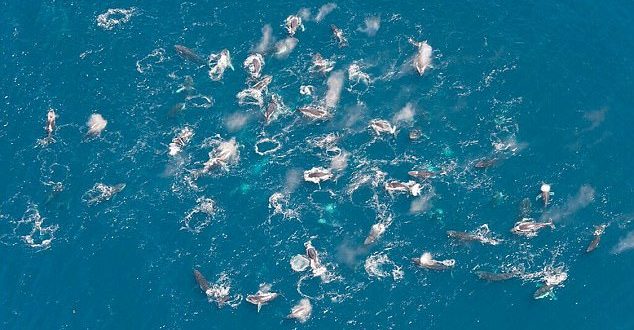Humpbacks have been gathering in large groups in a bizarre never-before-seen behaviour that is baffling researchers.
According to a research published in Plos One on 1 March, based on data collected on three separate research cruises in 2011, 2014 and 2015, as well as a handful of public observations from aircraft, there have been 22 instances in which groups of up to 200 humpbacks were spotted feeding intensively off the south-western coast of South Africa.
Aside from the size of these groups, the location of these pods — thousands of kilometres further north from their typical feeding grounds in the polar waters of the Antarctic – is also unusual.
“It’s quite unusual to see them in such large groups,” Gísli Vikingsson, head of whale research at the Marine and Freshwater Research Institute in Iceland told New Scientist.
Humpbacks are typically known to stay in the polar regions of the Antarctic during the summer. There they feed on krill and build up fat stores before making the journey to warmer waters once winter sets in. Female whales give birth during this time spent in the tropical and subtropical regions.
“I’ve never seen anything like this,” Ken Findlay, lead author of the study from the Cape Peninsula University of Technology in South Africa, said. He offered one possible explanation to the new pattern.
There is only one record of humpback whales feeding off the coast of South Africa, which was indentified close to a century ago. Since then, the population of whales has dropped significantly due to whaling. “It’s possible that the behaviour was occurring but just not where it was visible,” he opined. “Because there were so few of them, we may not have seen it.”
Vikingsson pointed out that over the recent decades; their population has increased at higher rate. “Suddenly they seem to have overcome some threshold and have begun to increase very fast,” he said.
Concluding, the team wrote: “Reasons for this recent novel behaviour pattern remain speculative, but may relate to increasing summer humpback whale abundance in the region. These novel, predictable, inter-annual, low latitude feeding events provide considerable potential for further investigation of Southern Hemisphere humpback feeding behaviours in these relatively accessible low-latitude waters.”
Agencies/Canadajournal
 Canada Journal – News of the World Articles and videos to bring you the biggest Canadian news stories from across the country every day
Canada Journal – News of the World Articles and videos to bring you the biggest Canadian news stories from across the country every day



